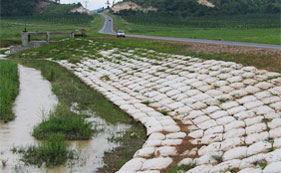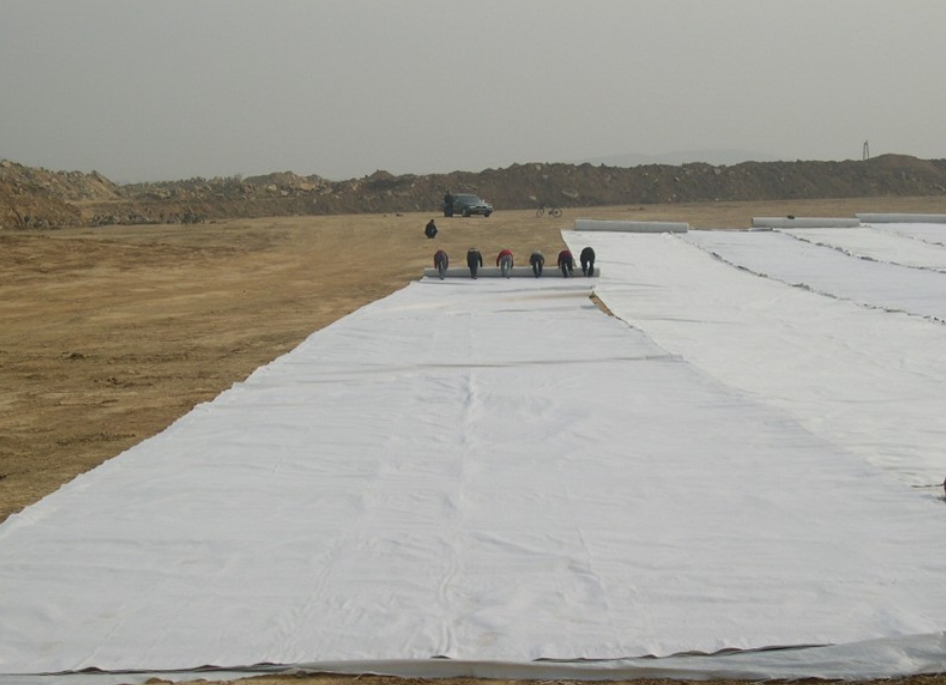
 Back to List
Back to List

1. Composite geomembrane construction method
1. Construction preparation
1) Composite geomembrane material quality inspection The composite geomembrane used in this project is a two-cloth-one-membrane composite geomembrane. The requirements: cleaning of the embankment, leveling the site, removing all sharp-angled debris, backfilling and ramming the under-slope, and cutting the slope. After leveling, it is qualified by the supervision and acceptance to provide a working surface for laying the composite geomembrane.
2) Splicing in the geomembrane field In order to facilitate the construction and ensure the splicing quality, the composite geomembrane should be as wide as possible to reduce the amount of splicing on site
2. Laying of composite geomembrane
1) Laying method of composite geomembrane Laying of composite geomembrane is divided into two parts: bottom laying and slope laying. Laying method: horizontal rolling along the channel axis. After the sloping surface has passed the acceptance inspection, it is rolled along the slope axis direction, and the composite geomembrane connection with the bottom of the canal adopts a T-shaped connection.
2) Technical requirements for laying of composite geomembrane
Laying should be carried out in dry and warm weather. In order to facilitate the splicing and prevent stress concentration, the composite geomembrane is laid in a wave-shaped relaxation method with a margin of about 1.5%. After spreading, it should be flattened and opened in time. The composite geomembrane and slope are required. The surface is anastomosed and smooth, without protrusions and wrinkles. The construction personnel should wear flat-bottomed cloth shoes or soft rubber shoes. Spike shoes are strictly prohibited to avoid stepping on the geomembrane. If the geomembrane is found damaged during construction, it should be repaired in time.
3. Splicing of composite geomembrane
1) This project uses two-cloth and one-membrane composite geomembrane, and the welding is constructed by hot-melt welding. In order to ensure the welding quality, the welding should be carried out in the factory as much as possible, but for the convenience of construction, the width of the composite geomembrane should not be too wide. Must be spliced at the construction site.
2) The welding quality of composite geomembrane is the key to the success or failure of composite geomembrane's anti-seepage performance. Therefore, the welding of geomembrane must be done well to ensure the welding quality. Therefore, the welding of geomembrane should be performed by the manufacturer’s professional and technical personnel. , Instruction, training, using special welding equipment for geomembrane.
3) The welding process of two-cloth and one-membrane composite geomembrane in this project:
4) Welding process: After the first geomembrane is laid, the second geomembrane is reversely laid on the first one, and the welding edge direction of the two films is adjusted to overlap about 7-10cm.
5) Before welding, blow off the sand, soil and other dirt on the membrane surface with a hair dryer to ensure that the membrane surface is clean. Before the formal welding, perform trial welding according to the construction temperature to determine the walking speed and welding temperature. Generally, the walking speed is 1.5~ 4m/min, the welding temperature is 250-350 degrees. Two splicing welds, each with a width of 7-9mm, leaving a cavity of 10mm between the two welds, use this cavity to check the quality of the weld.
4. Anchorage of composite geomembrane
1) The upper part of the composite geomembrane is anchored by a composite geomembrane of sufficient length embedded at the top of the embankment. 2) Cushion and concrete protection. A 10cm sand cushion is evenly laid on the top of the composite geomembrane, and 10cm concrete is laid after leveling and tapping. After the sloping surface composite geomembrane is qualified, it should be covered with a mat laminated cover in time to prevent wind blowing and the composite geomembrane is exposed to aging. At the same time, concrete protection should be done to strengthen the protection of the composite geomembrane.
2. Construction quality control of composite geomembrane
The construction quality control of composite geomembrane includes quality control of incoming raw materials, control of construction operation process, and quality inspection after construction.
1) Raw material quality control The composite geomembrane entering the site must have the certificate of conformity, performance and characteristic indicators provided by the manufacturer.
2) Construction operation process control. Before laying the composite geomembrane, weave the construction organization design, explain the laying method and technical measures, and use it after approval by the supervisor. The construction personnel should wear flat shoes or soft rubber-soled shoes for laying. Step on the geomembrane, so that it can be laid and pressed. The laying of the composite geomembrane should be coordinated with the laying of the protective layer. In splicing, the quality of composite geomembrane welds is the key to splicing. In construction, joint inspection must be strengthened. The inspection methods include visual inspection and on-site leak detection. Visual inspection method: After the composite geomembrane is welded, observe whether there is any missing joints, whether the joints are burnt, whether there are wrinkles, whether they are evenly spliced, etc. The on-site leak detection uses the inflation method to detect the welds. The welds are double strips with a cavity of about 10mm between the two. Seal both ends of the section to be tested, insert an air needle, and inflate to 0.05mpa~0.20mpa , Observe for 0.5min, observe the vacuum gauge, if there is no drop in the air pressure, it means that there is no leakage, weld the grid, otherwise find the reason and repair it in time. The anchoring of the upper and lower parts of the composite geomembrane is an important link, and the construction shall be carried out in strict accordance with the construction drawings and after the supervision and acceptance.